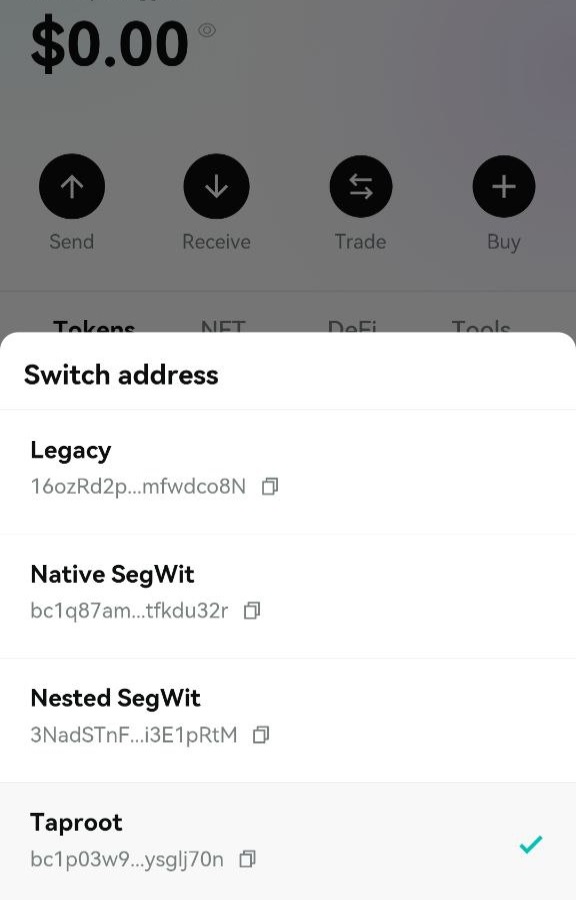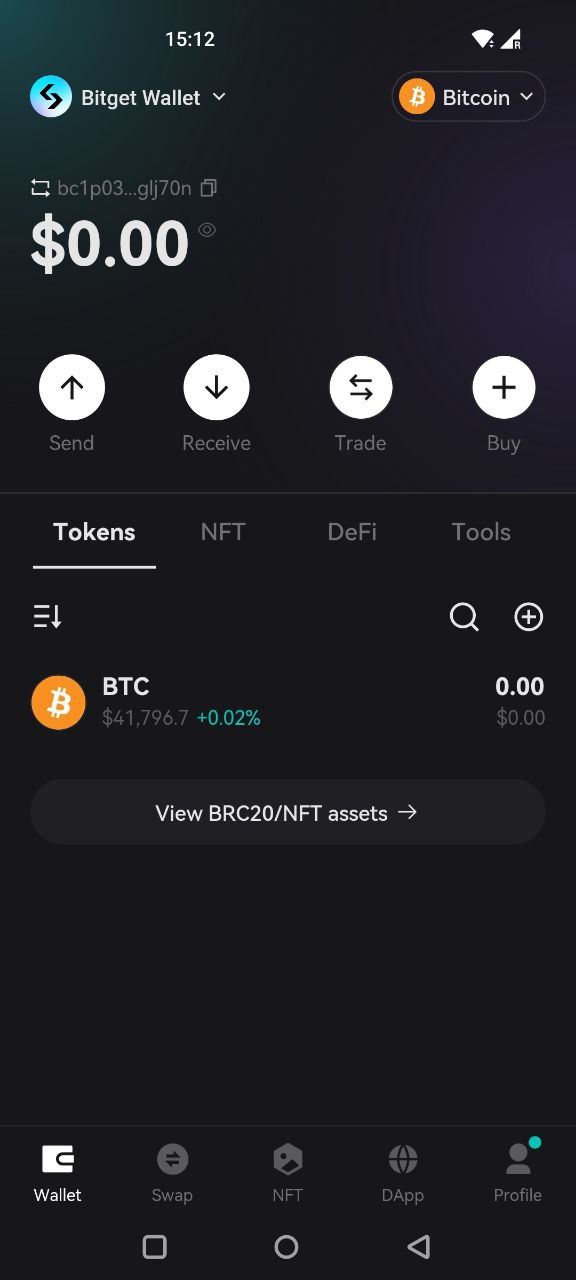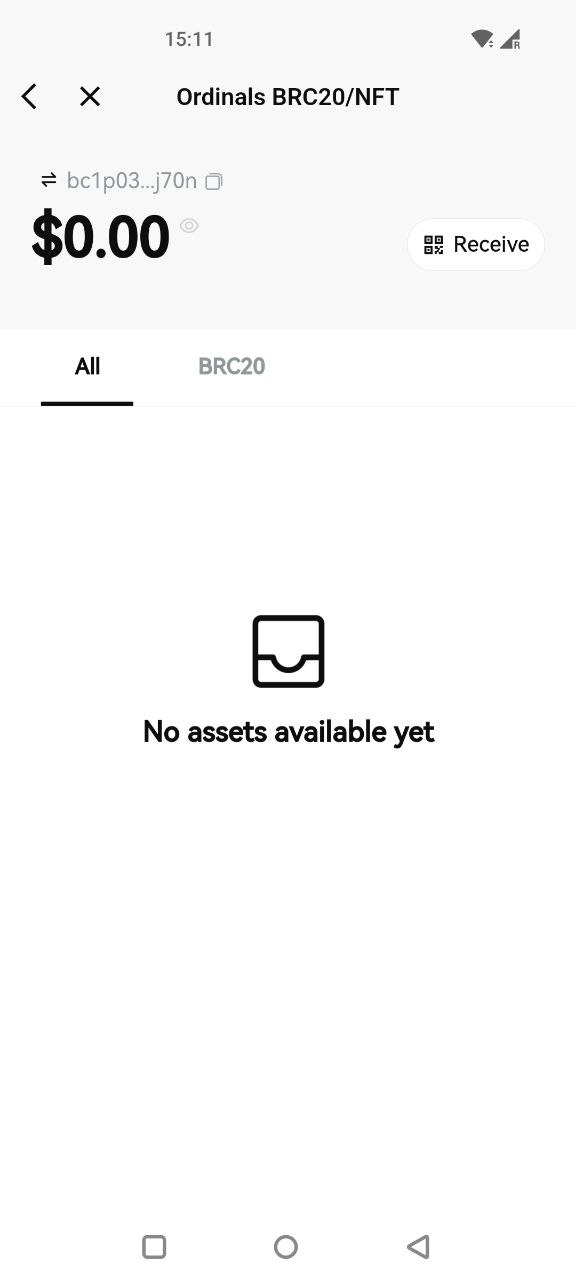
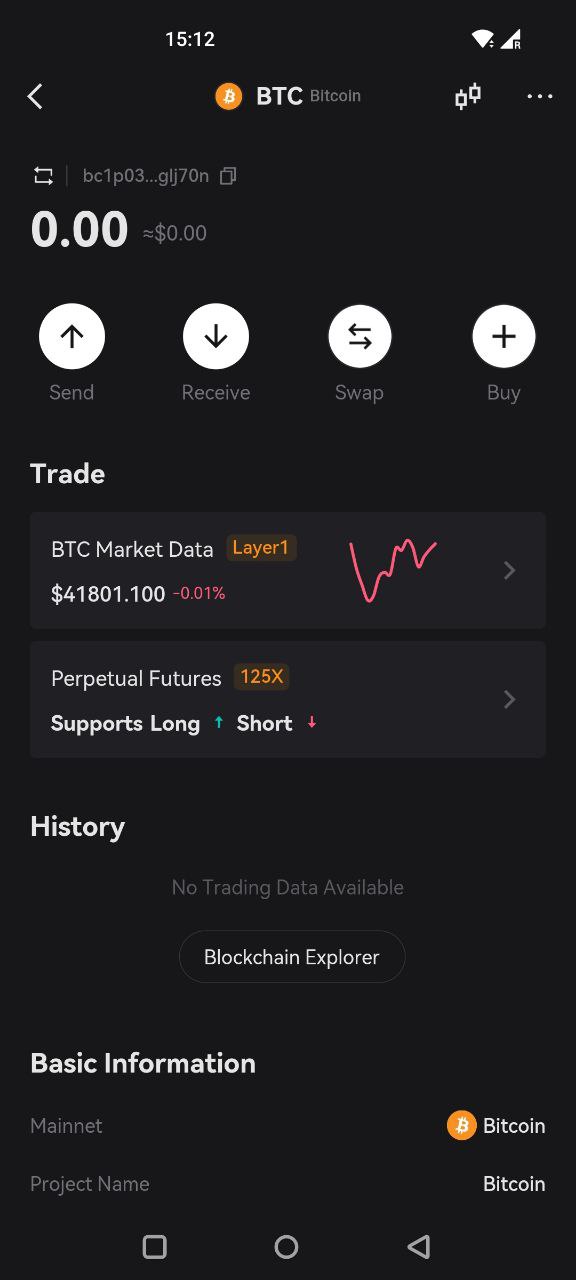
How to Create a BRC20 Wallet in Bitget Wallet
- 1. Launch Bitget Wallet and create a new wallet.
- 2. Select “Add Mainnet” and choose “Bitcoin”.
- 3. Return to the homepage of Bitget Wallet. The Bitcoin network is now showing on the homepage.
- 4. Tap "View BRC20/NFT assets" to display, send and receive BRC-20 tokens now!
You can also use our OTC feature to buy BTC with fiat currency and then inscribe BRC-20 tokens and Ordinals.
BRC20 Wallet Features
BRC20 DApps
Bitget Wallet DApp supports all kinds of BRC20 DApps, including DeFi, NFT, GameFi, Bridge, Exchange, Mine, Tools, Social, and Loan. All the latest and most popular BRC20 projects are listed in the Bitget Wallet DApp section. Users can effortlessly access the BRC20 ecosystem through Bitget Wallet DApp Browser, exploring trending DApps such as UniSat, BTCTool, Magic Eden, Ordinals Market, and more.
前往 Bitget DApp 瀏覽器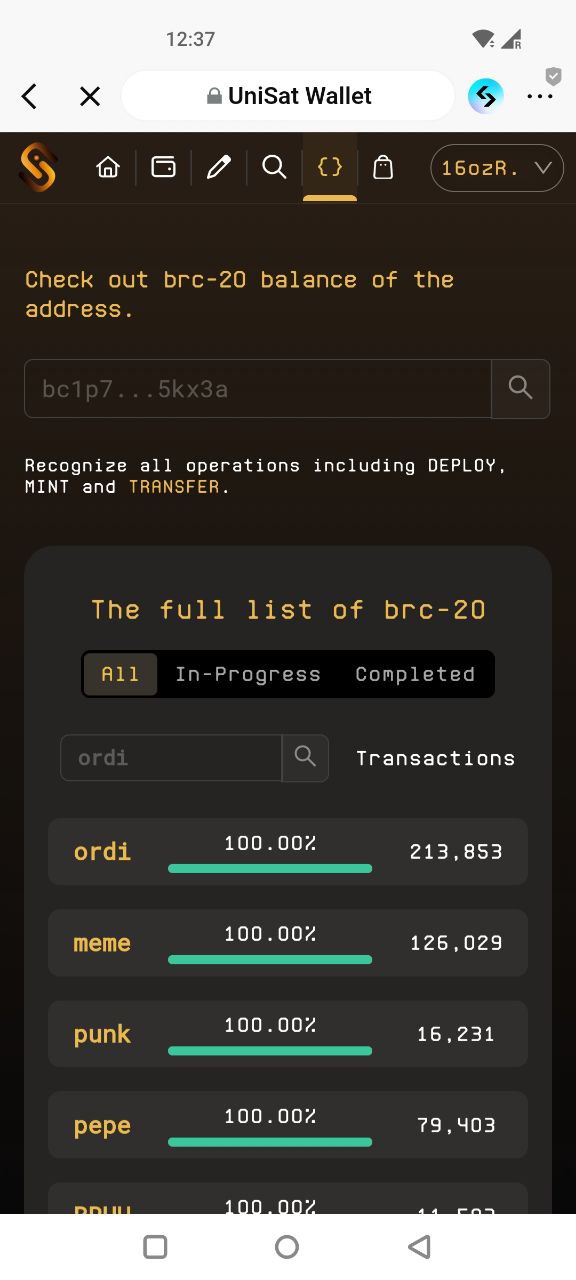
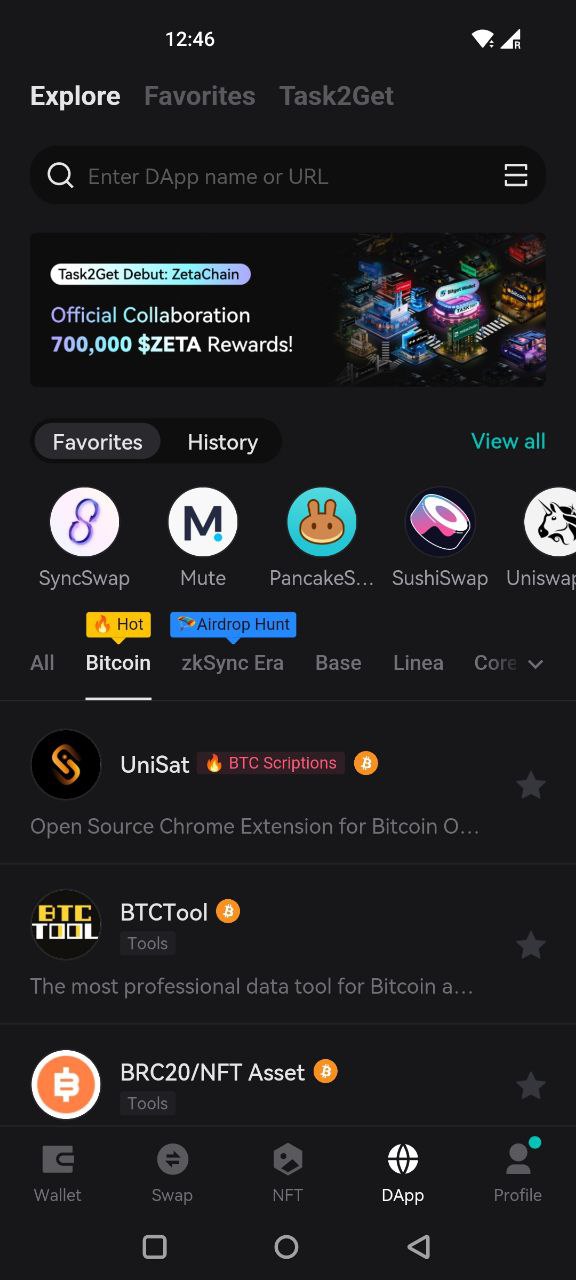
FAQ
How to deposit BRC20 tokens into BRC20 Wallet? 

What is the best BRC20 Wallet? 

How to download BRC20 Wallet and create a BRC20 Wallet in Bitget Wallet? 

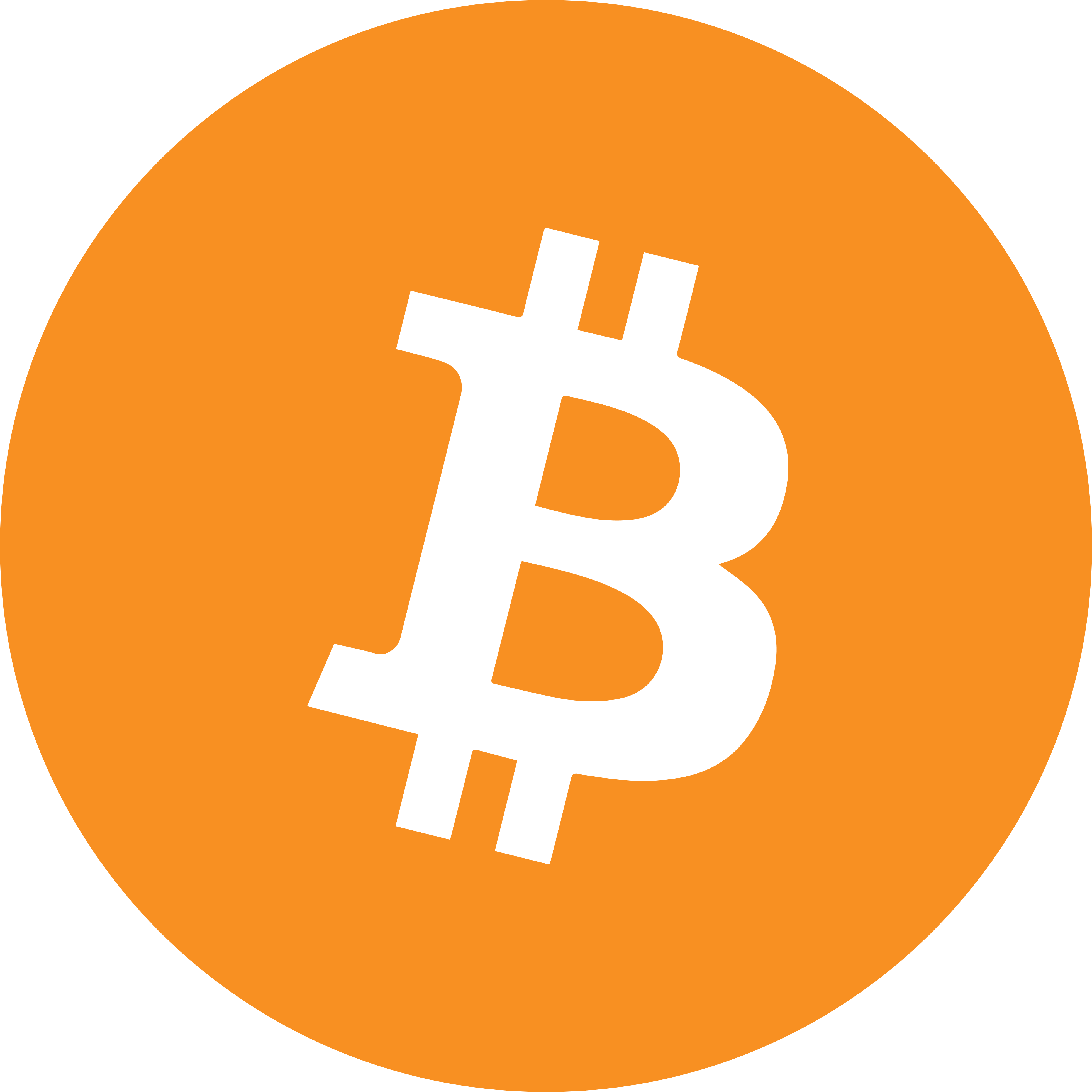
About BRC20
What is BRC20?
The BRC-20 token standard, or simply BRC20, is a new fungible token form that uses Ordinals and Inscriptions for token operations stored on the Bitcoin base chain. Unlike the ERC-20 standard used on Ethereum, it doesn't interact with EVM chain smart contracts but is a script file stored on the Bitcoin network. These tokens, distinct from Bitcoin, represent different assets and are stored as JSON script files on the Bitcoin blockchain. They exist in a separate secondary market, needing specialized software for sourcing, categorizing, and displaying from the blockchain.
What is a BRC20 wallet?
A BRC20 wallet is a digital wallet designed to store Bitcoin-based tokens that conform to the BRC20 token standard. Bitget Wallet is a mobile wallet that supports a variety of blockchain assets, including Bitcoin-based BRC20 tokens. With BRC20 Wallet, users can easily store and manage their BRC20 tokens, view their balance, send and receive tokens. The wallet also offers features such as multi-currency support, real-time market information, and decentralized exchange. Bitget Wallet's support for BRC20 tokens makes it a popular choice among users who hold these tokens.
What are the features of BRC20?
BRC-20 tokens, still in their early stages, attract interest due to their interchangeability on various crypto exchanges. These tokens, built on the Bitcoin protocol, present a less intimidating option to trading Bitcoin directly, especially for beginners. Notable for their robust security, these tokens benefit from the proof-of-work consensus mechanism of Bitcoin, ensuring transaction safety. BRC-20 tokens are also seamlessly integrated into the Bitcoin ecosystem, encouraging developers to create new applications on top of it, thus fostering wider adoption and diverse use cases.
What are Bitcoin Ordinals?
Bitcoin Ordinals introduce a novel concept on the Bitcoin blockchain, enabling the creation of unique digital assets similar to NFTs. This is done by using the blockchain's smallest unit, the satoshi. Each satoshi receives a sequential identifier, known as an ordinal, which is assigned based on the order it was mined. This feature allows for each satoshi (sats) to be individually recognized and tracked. The key functionality of Bitcoin Ordinals is the ability to 'inscribe' data, like images or text, onto satoshis. These inscriptions turn them into distinct, verifiable digital assets, unlike the interchangeable nature of fungible tokens. These inscribed sats are non-fungible and unique, comparable to NFTs on other blockchains. Utilizing the security and decentralization inherent to the Bitcoin network, Bitcoin Ordinals present a new method for creating and managing rare digital assets on the Bitcoin blockchain.
What are the differences between BRC-20 tokens and Ordinals?
BRC-20 tokens and Bitcoin Ordinals are distinct entities within the Bitcoin blockchain, each serving different functions. Bitcoin Ordinals facilitate the creation of unique digital assets, similar to NFTs, on the Bitcoin blockchain. This process involves assigning a sequential 'ordinal' number to each satoshi, enabling the identification, tracking, and transfer of individual satoshis. Users have the capability to inscribe data onto a satoshi, like images or text, thereby converting it into an immutable digital collectible. Depending on their application by owners, these Ordinals can be either fungible or non-fungible. Conversely, BRC-20 tokens represent a newer token standard on the Bitcoin blockchain, drawing inspiration from Ethereum's ERC-20 tokens. In contrast to Ordinals, BRC-20 tokens are fungible, with each token being exchangeable for another of the same kind. BRC-20 tokens diverge from ERC-20 in that they don't utilize smart contracts but instead rely on embedding JSON data within ordinal inscriptions for token management. These tokens are semi-fungible and have garnered interest due to their capability to facilitate the creation and transfer of tokens directly on the Bitcoin blockchain.
What are the popular BRC20 tokens?
The BRC-20 standard has significantly influenced cryptocurrency, with more than thousands of tokens already created. Although many are meme coins with no practical uses, they quickly garnered much attention from Web3 investors. With the rising interest in BRC-20 tokens, the potential for profit and risk could be very high. Here's a brief overview of some leading BRC-20 tokens: ORDI: A first-of-its-kind BRC-20 token on the Bitcoin blockchain, ORDI employs the Ordinals protocol for asset tokenization. It has a fixed 21 million token supply, representing a significant step in Bitcoin's adaptation to NFT-like assets. SATS: A BRC-20 memecoin, SATS mirrors Bitcoin's supply times 100 million. It's a playful, educational tool on the Bitcoin blockchain, paying homage to the smallest Bitcoin unit, the satoshi. PIZA: This memecoin celebrates Bitcoin's famous Pizza Day with a 21 million supply, commemorating the day 10,000 BTC were exchanged for pizzas. RATS: An animal-themed BRC-20 meme token with a 1 trillion supply, RATS is known for its scarcity and unique approach in the crypto sphere. MUBI: MultiBit (MUBI) is a DeFi protocol that facilitates the transfer of BRC-20 tokens to ERC-20 tokens across EVM networks. TURT: TurtSat (TURT) focuses on community development in the Ordinals ecosystem, aspiring to be its Gitcoin. It emphasizes global community involvement and innovation.
What is the future of BRC-20?
The potential of BRC-20 tokens, currently at an experimental stage on the Bitcoin blockchain, is closely linked to the evolving dynamics of the cryptocurrency sector. BRC-20, as a platform for issuing fungible tokens, has garnered attention by leveraging Bitcoin's foundational layer, similar to how the Ordinals project has reignited Bitcoin's relevance in the NFT space. The range of BRC-20 tokens is expanding in the market, yet this growth comes with speculative investment risks. BRC-20 offers possibilities in tokenizing tangible assets and various other uses. However, the community's reaction is a blend of enthusiasm and caution, underlining the need for prudent investment strategies. The trajectory of BRC-20 is being carved out by its potential applications, market trends, and continuous developer engagement. Nevertheless, it faces uncertainties and risks, making its path in the cryptocurrency landscape both full of promise and unpredictability.
Should we invest in BRC-20 now?
Investing in BRC-20 tokens involves a nuanced assessment of several critical factors: Market Dynamics: Popular BRC-20 tokens like MEME, PIZA, and RATS are often categorized as memecoins. Their value largely stems from speculative trading rather than inherent utility, and they generally lack practical real-world applications. This makes their value highly sensitive to market sentiments. Niche Tokens and Market Liquidity: Some BRC-20 tokens, not listed on major exchanges, fall into the niche category and suffer from limited liquidity. They might have a nominal price but lack significant market penetration, presenting risks due to potential challenges in selling these tokens. Community Perception: The Bitcoin community's stance on BRC-20 tokens is polarized. A segment perceives them as a positive addition, introducing new functionalities and attracting more users and developers, which could potentially increase the demand for BTC. Conversely, others argue that these tokens primarily contribute to network congestion without providing substantial benefits to Bitcoin's ecosystem. Effect on Bitcoin Miners: The rise of BRC-20 has positively impacted Bitcoin miners by boosting transaction volumes and, consequently, mining revenues. In summary, while BRC-20 tokens introduce innovative dimensions to the Bitcoin network and present opportunities, particularly for miners, they also carry risks linked to market speculation, liquidity challenges, and uncertainties in future applications. Prospective investors should thoroughly research and weigh these elements before venturing into the BRC-20 token market.
How to buy BRC-20?
You can buy BRC-20 tokens on a crypto exchange like Bitget Exchange. Here are the steps to follow: 1. Sign in to Bitget Exchange. 2. Find BRC-20 tokens using the search bar in the "Market" section, like searching for ORDI. 3. Select a trading pair, such as ORDI/USDT for spot or ORDIUSDT for perpetual contracts. 4. Click "Trade", choose the trade amount and order type (limit, market, trigger), and complete your transaction. The process is consistent on both desktop and mobile platforms.
How to mint BRC-20?
1. Go to the Bitget Wallet homepage and open the "DApp" browser. 2. Select "UniSat" in the "Bitcoin" DApp section. 3. Link your Bitget Wallet to UniSat and choose the BRC-20 token you want to mint. 4. Select your network fee, agree to the terms, and tap "Submit & Pay Invoice." 5. Wait for the transaction to finish completing your BRC-20 inscription.


